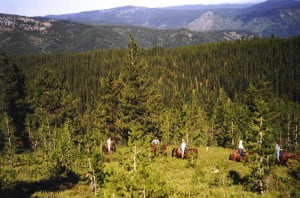I have followed the trail of Lewis and Clark from the beginning near modern St. Louis, Missouri, up the Missouri River, across the Rocky Mountains, and down the Columbia River to the Pacific Ocean. President Thomas Jefferson had instructed them to"record the mineral productions of every kind... Volcanic appearances ... Climate, as characterized by the thermometer, by the proportion of rainy, cloudy, and clear days; by lightning, hail, snow, ice; by the access and recess of frost; by the winds prevailing at different seasons; the dates at which particular plants put forth or lose their flower or leaf; times of appearance of particular birds, reptiles, or insects." They began their journey in 1804, returning in 1806.

On my travels, I comparing what Lewis and Clark wrote about nature in the American west with what I saw in our times. I went by horseback, canoe, motorboat, foot, and automobile. I lived for a while in Portland, Oregon, where it was easy to explore their times on the Columbia River. Here are some of the calendar of events they encountered and saw in modern times. I will update this during the year.
The complete description of my travels in comparison to Lewis and Clark’s is in my book: Beyond the Stony Mountains: Nature in the American West from Lewis and Clark to Today (ebook 2012, New York, Croton River Publishers; print edition 2004, Oxford University Press, N.Y). The stories told here are from this book.
If this interests you, you can order a copy of this book by going to my signed book page.
Let’s begin with how their three years began.
Beginning of their first year: January, 1804: Lewis and Clark hadn’t started on their journey. They were camped near St. Louis, hiring men to go with them on the expedition. On January 6, 1804, William Clark, in the midst of these busy preparations, was up and out at midnight to save one of his boats. "The banks were Caveing in," he wrote later that day, "and large Pees of the bank sliped in, which obliged all hands to, go Down & make all secure." Even though he and Lewis had not yet begun their trip up the Missouri, over the Rocky Mountains, and down the Columbia, nature was already challenging them. As Clark continued the preparations for the journey, the river rose and fell, requiring constant attention to the safety of the boats.
Beginning of their second year, January 1805. They spent this winter with the Mandan Indians, staying in a fort they built near today’s Bismarck, N.D. They carried a thermometer with them, and recorded temperatures that month from -40 to +35 degrees Fahrenheit. Probably these were the first weather records for North Dakota, as well as much of the rest of the country they had passed through in 1804.
During their third January, 1806, the expedition was camped near the mouth of the Columbia River on what is today the Oregon side of the river’s estuary. The fort they built, which they named Fort Clatsop after the local Indians, has been reconstructed as the Fort Clatsop National Historical Park of the National Park Service and is well worth a visit. As usual on the Oregon coast in the winter, it was cold, rainy, cloudy, and many of the men were suffering from colds, as they built their fort and then began to warm up next to their fireplace. They began building the fort on December 11, 1804 in the rain. On that day, several of the men suffered from "excessive dampness" and four had violent colds, one had dysentery, one had "tumors on his legs," and two had injured their limbs.
On January 6, 1806, Clark left the fort with a group of men on one of the rare clear days of that winter. He wrote that "the evening a butifull Clear moon Shiney night, and the ist fair night which we have had for 2 months." Twelve men went in two canoes. They pursued and killed one elk, which they ate entirely.
That same day, the Indians gave two of the men "a considerable quantity of the blubber of a whale which perished on the coast some distance S. E.," Lewis wrote, adding that the blubber was "white & not unlike the fat of Poark, tho' the texture was more spongey and somewhat coarser." He ate it cooked and "found it very pallitable and tender, it resembled the beaver or the dog in flavour."
(All the quotes from the Lewis and Clark journals are from the recent, excellent, authoritative edition edited by historian Gary Moulton ---The Journals of the Lewis and Clark Expedition. Lincoln, NE: University of Nebraska Press. Moulton kept their original spelling, which in those days was much more casual than we treat spelling today, except of course on the internet. And they were taking notes as they traveled up the Missouri and down the Columbia River in all kinds of weather, in all kinds of situations.)

Leave a Reply